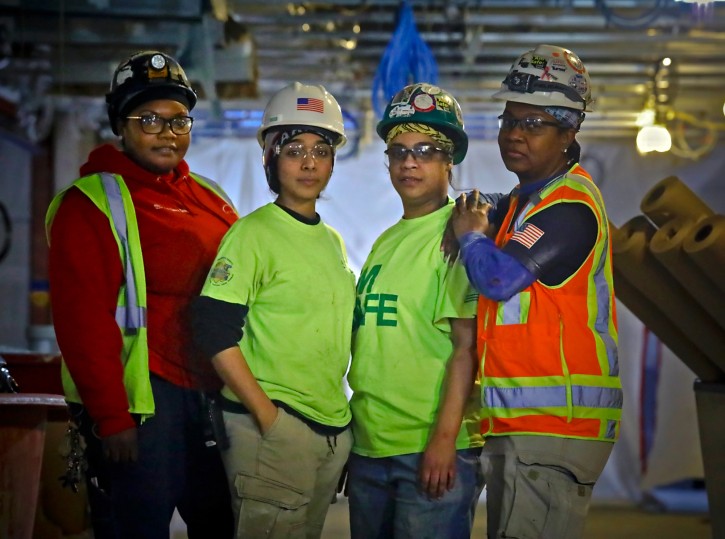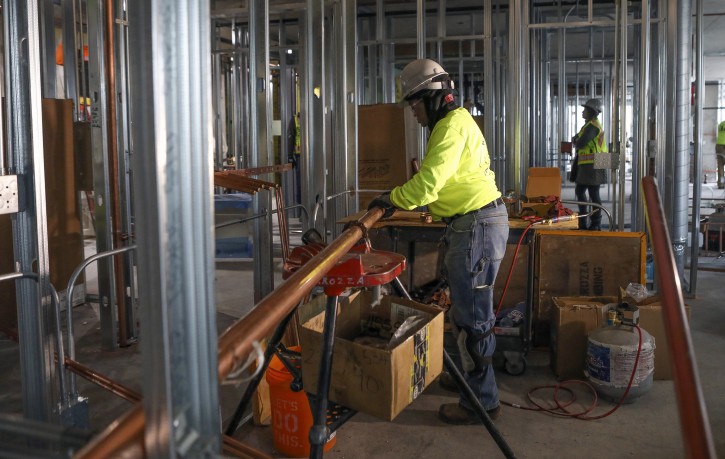 New York – Tameeka Gwyn is used to schlepping concrete weighing as much as 60 pounds (27 kilograms) around a construction site. For Janna Rojas, it’s a cinch to carry metal pipes as heavy as 100 pounds (45 kilograms) going into new plumbing.
New York – Tameeka Gwyn is used to schlepping concrete weighing as much as 60 pounds (27 kilograms) around a construction site. For Janna Rojas, it’s a cinch to carry metal pipes as heavy as 100 pounds (45 kilograms) going into new plumbing.
Subscribe to our Daily Roundup Email
“When you first do it, it’s quite a shock, but it’s reality,” says Gwyn, who with Rojas is helping build a Manhattan high-rise for the Memorial Sloan Kettering Cancer Center in Manhattan.
They are some of the new faces of the 21st-century American construction worker — with women slowly making inroads in an industry still dominated by men. While there has been progress thanks to a rebounding economy, the federal Bureau of Labor Statistics found women represent only 3.4 percent, or about 285,000, of the nation’s 8.3 million construction workers. Over the last decade, the total number of women in the construction industry has risen by about 31 percent.
One program in New York City addresses the gender gap head-on, kickstarting recruits’ training while gaining a promise from unions to try to reserve 15 percent of on-site actual apprenticeships for women. The Building and Construction Trades Council of Greater New York is working with a nonprofit group, Nontraditional Employment for Women (NEW), which runs a pre-apprenticeship program for women who want to become plumbers, electricians, carpenters and members of other trades.

“We’ve had a real shift in terms of really working with the unions as partners in our work because they recognize that the need for a diverse workforce, a workforce that represents the population of New York City and beyond,” said NEW president Kathleen Culhane. She says they recruit trainees by distributing flyers at job fairs, community organizations and unemployment offices in addition to social media outreach.
It’s clear the industry has a long road ahead to even out its gender discrepancy — one that is hardly surprising for a job often characterized by male workers whistling at women who walk past job sites — despite a push from the #MeToo movement that is leading to sweeping changes in many occupations around the globe.
“The #MeToo movement has highlighted what’s right and what’s wrong, and women are being accepted more and more on the job sites,” says Gary LaBarbera, president of the Building and Construction Trades Council, an organization of 15 labor union affiliates representing 100,000 workers.
Philip LoMonaco, the foreman of the cancer center project, has seen that happen firsthand. He says he first saw a woman on a construction job about a decade ago. Now, there are 200 female workers, including Gwyn and Rojas, building the high-rise on Manhattan’s East Side — representing about 5 percent of all workers on that project, according to the builder, Turner Construction. Jacobson & Company, a large carpentry contractor in metropolitan New York, says 9 percent of its nearly 300 employees are women.
Many of the female workers come from low-income circumstances and some are single mothers used to juggling multiple jobs to pay the bills. But once they break into the trades, these women are better off than those in other lines of work, facing a smaller wage gap compared to men. The Bureau of Labor Statistics says women in construction are paid 96 cents on the dollar compared to their male colleagues, versus only about 80 cents on the dollar in the general workforce.

Gwyn finished her five-year apprenticeship in 2015. The 30-year-old plumber had gone to college to become a teacher, but left school when her student loans mounted. She says she now earns about double what she would have made as a teacher.
Rojas, a 37-year-old plumbing apprentice at the hospital site, is hoping for an eventual six-figure salary after she finishes the program.
Since 2013, about 1,500 apprentices have come out of NEW’s tuition-free trade school, housed in a former firehouse in Manhattan. They spend seven weeks being introduced to basics in such skills as carpentry and electrical work, as well as using a measuring tape to execute a design and mathematical equations to accurately match materials into a space. Similar programs have popped up in Illinois, Vermont, Oregon, Wisconsin and Washington state.
“People might say that it’s a man’s job because it’s dominated by men, because women has been frozen out of this industry for so long,” said Zakiyyah Askia, a plumbing apprentice in a program run by the nonprofit Chicago Women in Trades. “And now that the opportunities are presenting themselves, then it’s time for us as women to seize this opportunity.”
The NEW program also puts its workers to the test physically.
“Every day, we had to carry ladders and buckets with, like, 60 pounds of concrete up and down stairs,” says Gwyn.
In addition to the physical challenges of their jobs, some of the women in the NEW program say they’ve encountered social hurdles — what one called “old-school behavior” such as some male co-workers reluctant to ask them to do equal work, or occasional attempts at unwelcome flirtation.
Gwyn says she made sure she looked “stern and serious, because if you smile, they sometimes say, ‘Oh, she’s cute’ and try to pursue you.”
“I’d say, ‘Thank you, but no thank you!’ I came here to work, and the more I’m here, the less it happens,” she says.
The program provides sexual harassment workshops during its training and all workers in participating trade unions are given the same training. It also ensures women have access to restrooms as well as safety gear and clothing that fits them.
The modest progress women have made in the industry has not come easily or quickly.

In 1985, 19 women sued a New York City public corporation and a real estate firm in Manhattan federal court, saying they were unfairly denied jobs for which they were qualified because they were female. The court approved a settlement requiring builders to make good-faith efforts to hire women-in-training.
LaBarbera, the union president, calls the women coming in through apprenticeships “trailblazers.”
And generally, neither gender nor age is impediments.
For Myrtle Wilson, a 49-year-old laborer who had previously worked multiple jobs and struggled to raise her kids, the past two years working on the Memorial Sloan Kettering project doing “a little bit of everything” have been a game-changer.
“I have watched this job literally come from the ground up, and it’s been an amazing experience,” she says with a grin.

Whats up with this craze that women have to do everything men do? Hashem made two different kinds of humans males, and females. We are made of different cuts. Men lift things and do more manual work. Females do a better job in raising kids running house holds and even some office jobs. As long as they are equally respected and valued in the roles they shine in best to serve society what is wrong? Men can’t raise kids, run house holds, be nurses, run efficient offices etc… And women can’t do most blue collar heavy lifting stuff? Why must everyone fit in everybody’s shoes? Why not value each other for who we each are?
Am I missing something in this PC world?
Archy is a meshuganah, whose archaic ideas are more in tune with the religious police of Saudi Arabia, and the Taliban of Afghanistan. Incidentally, Archy, the next time that you are on a commercial flight, and you discover of the flight, that the pilot is a female, are you going to request from the flight attendants that they give you a parachute, so you can jump off? Actually, when you make your next airline reservation, you should state “I, Educated Archy, a distinguished and scholarly commentator onf VIN News, request only an all male crew, as I don’t trust that a female is capable of safely flying the plane”.